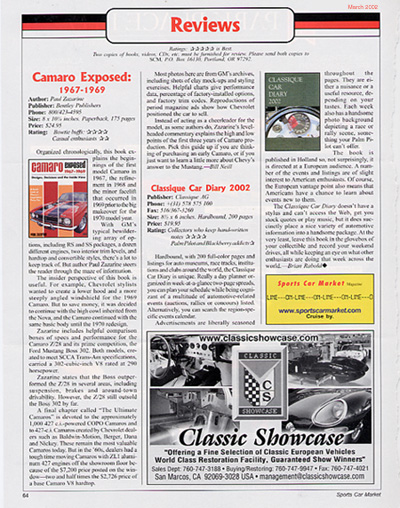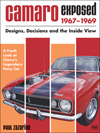|
A Fresh Look at Chevy's Legendary Pony Car |
Camaro Exposed:
1967-1969
Price: $44.95
|
Camaro Exposed: 1967-1969
Organized chronologically, this book explains the beginnings of the first model Camaro in 1967, the refinement in 1968 and the minor facelift that occurred in 1969 prior to the big makeover for the 1970 model year.
With GM's typical bewildering array of options, including RS and SS packages, a dozen different engines, two interior trim levels, and hardtop and convertible styles, there's a lot to keep track of. But author Paul Zazarine sterrs the reader therough the maze of information.
The insider perspective of this book is useful. For example, Chevrolet stylists wanted to create a lower hood and a more steeply angled windshield for the 1969 Camaro. But to save money, it was decided to continue with the high cowl inherited from the Nova, and the Camaro continued with the same basic body until the 1970 redesign.
Zazarine includes helpful comparison boxes of specs and performance for the Camaro Z/28 and its prime competitio, the Ford Mustang Boss 302. Botrh models, created to meet SCCA Trans-Am specifications, carries a 302-cubic-inch V8 rated at 290 horsepower.
Zazarine states tha the Boss outperformed the Z/28 in several areas, including suspension, brakes and around-town drivability. However, the Z/28 still outsold the Boss 302 by far.
A final chapter called ?The Ultimate Camaros? is devoted to the approximately 1,000 427 c.i. powered COPO Camaros and 427-c.i. Camaros created by Chrolet dealers such as Badwin-Motion, Berger, Dana and Nickey. These remain the most valuable Camaros today. But in the ?60s, deaers had a tough time moving Camaros with ZL1 aluminum 427 engines off the showroom floor because of the $7,2000 price poster on the windows ? two and half times the $2,726 price of a base Camaro V8 hardtop.
Most photos here are from GM's archives, including shots of clay mock-ups and styling exercises. Helpful charts give performance data, percentage of factory-installed options, and factory trim codes. Reproductions of period magazine ads show how Chevrolet positioned the car to sell.
Instead of acting as a cheerleader for the model, as some authors do, Zazarine;s level-headed commentary explains the high and low points of the first three years of Camaro production. Pick this guide up if you are thinking of purchasing an early Camaro, or if you just want to learn a little more about Chevy's answer to the Mustang.

![[B] Bentley Publishers](http://assets1.bentleypublishers.com/images/bentley-logos/bp-banner-234x60-bookblue.jpg)
